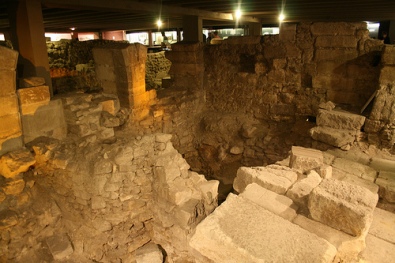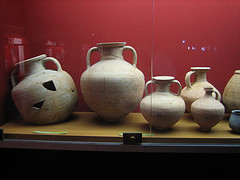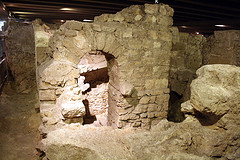

Plaza du Parvis Notre- Dame
Tel. 01 55 42 50 10
Subway: Cite
Open: Tue- Sun: 10am- 6pm Closed: 1 May, 1&11 Nov, 25 Dec, 1 Jan


The Crypte Archéologique de l'Île de la Cité, often referred to simply as the Paris Archaeological Crypt, is an underground archaeological museum located directly beneath the parvis (forecourt) of Notre-Dame Cathedral in the 4th arrondissement of Paris. Spanning approximately 200 meters in length and covering more than 2,000 years of urban history, it is Europe's largest archaeological crypt and serves as a window into the evolution of the Île de la Cité—the historic heart of Paris—from the Gallo-Roman city of Lutetia to the 19th century. Discovered during excavations between 1965 and 1972 (originally intended for an underground car park), the site was transformed into a public museum in 1980. It showcases in-situ ruins integrated with modern interpretive tools, such as interactive maps, touch screens, 3D animations, and virtual reality experiences, making it an immersive blend of ancient archaeology and contemporary technology. As of 2025, the crypt remains a key cultural site, attracting visitors interested in Paris's foundational history, though it is slated for potential renovations starting in 2026 that may involve temporary closures.
The crypt's history is intrinsically tied to the development of Paris
itself. The Île de la Cité has been inhabited since prehistoric times,
but the site's significance began with the Gallo-Roman settlement of
Lutetia in the 1st century AD, when it served as a key river port and
urban center on the Seine. Excavations in the 1960s and 1970s unearthed
remnants from this era, including parts of the city's defensive walls
built in the early 4th century to protect against invasions. Medieval
layers reveal the island's role as a religious and administrative hub,
with structures like the 12th-century Rue Neuve-Notre-Dame (a street
created to transport materials for Notre-Dame's construction) and
foundations from charitable institutions. By the 19th century, under
Baron Haussmann's urban renovations, the area saw the installation of
modern sewers, traces of which are also preserved.
The crypt was
established to protect and display these finds after the car park
project was abandoned due to their archaeological value. It provides a
chronological narrative of urban evolution: from Roman antiquity
(1st-5th centuries), through the Middle Ages (6th-15th centuries), to
the modern era (16th-19th centuries). This makes it a unique panorama of
Paris's transformation from a provincial Roman town to a medieval
capital and beyond. Notably, the site survived the 2019 Notre-Dame fire
unscathed, though access was temporarily affected during the cathedral's
reconstruction.
Architecturally, the crypt is a subterranean space designed to
preserve and exhibit ruins in their original context, with minimal
intervention to maintain authenticity. The layout follows a linear path
along the 200-meter expanse, guiding visitors through thematic zones
that correspond to historical periods. The structure is supported by the
modern concrete ceiling of the former car park project, which contrasts
with the ancient stonework below. Key architectural features include:
Gallo-Roman Elements: Exposed sections of the 4th-century city wall,
public baths (thermae) with hypocaust heating systems (underfloor
channels for hot air), and remnants of the ancient docking port along
the Seine, highlighting Roman engineering for urban infrastructure.
Medieval Structures: The basement of the former Hôtel-Dieu Chapel (a
medieval hospital), cobblestone traces of Rue Neuve-Notre-Dame, and
foundations of the Hospice des Enfants-Trouvés (an 18th-century
orphanage), showcasing medieval urban planning and charitable
architecture.
19th-Century Additions: Visible Haussmannian sewers,
demonstrating the industrial-scale renovations that modernized Paris.
The space is dimly lit to evoke an archaeological dig, with walkways
elevated above the ruins for non-intrusive viewing. Modern enhancements
include multimedia displays: interactive screens explaining stratigraphy
(layered soil deposits), models of ancient Lutetia, and a virtual
reality station offering a 5-minute immersive tour of Notre-Dame as it
appeared in the late 18th century (developed from Assassin's Creed:
Unity data, suitable for ages 7+). This blend of raw archaeology and
digital interpretation creates an engaging, educational environment.
The permanent exhibits focus on the in-situ archaeological vestiges,
providing a tangible connection to Paris's past. Over 150 artifacts and
structures are on display, including Roman pottery, medieval masonry,
and 19th-century infrastructure elements. Multimedia aids, such as
slideshows and 3D reconstructions, explain the site's evolution, with a
particular emphasis on how the Île de la Cité grew from a small island
settlement to the epicenter of French power.
Temporary exhibitions
add depth; as of November 2025, the featured show is "Dans la Seine" (In
the Seine), which portrays the history of the Parisian Seine through
objects recovered from its riverbed and banks. Spanning from prehistoric
times (e.g., ancient tools) to the 21st century (e.g., modern
artifacts), it includes nearly 150 items like Roman coins, medieval
weapons, and contemporary relics, presented alongside the crypt's ruins
to illustrate the river's role in shaping the city. This exhibition runs
alongside the permanent displays and highlights accidental discoveries
from dredging and construction projects.
Additional activities
include guided tours (1.5 hours, focusing on specific eras), concerts,
and family-oriented workshops with 3D animations. Audio guides are
available in English, French, and Spanish to enhance self-guided visits.
The crypt is accessible and family-friendly, with accommodations for
visitors with disabilities (e.g., ramps and adapted tours). As of 2025:
Location: 7 Place Jean-Paul II, Parvis Notre-Dame, 75004 Paris
(entrance on the Notre-Dame forecourt).
Opening Hours: Tuesday to
Sunday, 10:00 AM to 6:00 PM (last entry at 5:30 PM). Closed Mondays and
certain holidays; check the official site for updates, especially
regarding 2026 renovations.
Tickets: Full price €9; reduced €7 (for
students, seniors, etc.); free for under-18s, disabled visitors and
companions, and Paris Museum Pass holders. Tickets include access to
permanent and temporary exhibits; purchase online or on-site.
Getting
There: Metro Line 4 (Cité or Saint-Michel stations); RER B/C
(Saint-Michel-Notre-Dame); Buses 21, 24, 27, 38, 47, 85, 96. It's
centrally located, about a 5-minute walk from Notre-Dame.
Guided
Tours and Amenities: 1.5-hour tours available (book in advance); audio
guides €3. No on-site café, but nearby options in the Latin Quarter.
Photography allowed without flash; large bags prohibited.
Contact:
Official website: https://www.crypte.paris.fr/en. For real-time info on
exhibitions and events, refer to the site or tourism offices.
Visitors should allocate 1-2 hours for a thorough exploration, and
combining a visit with Notre-Dame (post-reconstruction) enhances the
experience.
As a UNESCO-recognized site tied to Notre-Dame, the crypt underscores Paris's role as a continuously inhabited urban center. It not only preserves physical history but also educates on themes like urban planning, riverine archaeology, and cultural continuity. With ongoing exhibitions like "The Seine," it remains dynamic, bridging ancient artifacts with modern narratives. For history enthusiasts, it's an essential stop, offering a subterranean contrast to the city's iconic skyline above.